E-Commerce Meets Emerging Technologies: An Overview of Research Characteristics, Themes, and Trends
Abstract
1. Introduction
| Reference | Focus |
|---|---|
| Franco-Castaño et al. [24] | E-commerce in general |
| Ferraz et al. [25] | After-sales attributes in e-commerce |
| Villa et al. [26] | E-commerce adoption factors |
| Bach et al. [27] | Evolution of distribution in e-commerce |
| Altarturi et al. [28] | Technological advancement applications in agricultural e-commerce |
| Rita and Ramos [29] | Consumer behavior and sustainability in e-commerce |
| Tran and Khoa [30] | Circular economy in e-commerce |
| Mumu et al. [31] | Trust in e-commerce |
| Penu et al. [32] | E-commerce and globalization |
| Chen et al. [33] | Cross-border e-commerce research trends |
| Daza et al. [34] | Sentiment analysis on e-commerce product reviews using machine learning and deep learning |
| Oğuz and Çetinoğlu [16] | Blockchain in e-commerce |
| Bawack et al. [17], Chung and Jain [18], Boukrouh and Azmani [19] | Artificial intelligence in e-commerce |
| Valencia-Arias et al. [20], Cardona-Acevedo et al. [21] | Artificial intelligence and recommender systems in e-commerce |
| Guamboa-Cruzado et al. [22] | Influence of machine learning in e-commerce |
| Mutemi and Bacao [23] | E-commerce fraud detection using machine learning |
- Which sources are listed at the top of the authors’ preferences for publishing the manuscripts around electronic commerce and emerging technologies, and what is their impact within the scientific community, considering multiple factors, such as the volume of academic publications, the H-index indicator, or even Bradford’s law?
- What insights can be uncovered according to the authors’ analysis and their production over time?
- Which are the most relevant affiliations in the area of electronic commerce and emerging technologies, and how can the scientific production with respect to the countries be characterized?
- What is exposed regarding the degree of collaboration within this domain, taking into account both the country collaboration map and the authors’ collaboration network?
- Based on the review of the top 10 most cited papers included in the data collection set, what insights can be drawn?
- Using the information discovered during word analysis, what are the key details that should be highlighted?
2. Materials and Methods
2.1. Dataset Extraction
- Science Citation Index Expanded (SCIE);
- Social Sciences Citation Index (SSCI);
- Arts & Humanities Citation Index (A&HCI);
- Emerging Sources Citation Index (ESCI);
- Conference Proceedings Citation Index—Science (CPCI-S);
- Conference Proceedings Citation Index—Social Sciences and Humanities (CPCI-SSH);
- Book Citation Index—Science (BKCI-S);
- Book Citation Index—Social Sciences and Humanities (BKCI-SSH);
- Current Chemical Reactions (CCR-Expanded);
- Index Chemicus (IC).
2.2. Bibliometric Analysis
3. Dataset Analysis
3.1. Dataset Overview
3.2. Sources
3.3. Authors
- Cluster #1: colored red, consisting of four authors (Chen J., Jiang J., Wu M.G., and Xu S.Y.). The collaborative research efforts of these authors primarily focus on the intersection of e-commerce platforms, emerging technologies, and supply chain optimization [77,78,79,80]. The work addresses critical challenges such as logistics inefficiencies, trust and security issues, and counterfeit product management by leveraging innovative technologies like blockchain, IoT, and mobile communication systems. The contribution of the papers included in the dataset is particularly valuable for enhancing the operational capabilities of small and medium enterprises (SMEs), promoting sustainability, and fostering trust in e-commerce ecosystems [77,78,79,80]. The selected studies provide both theoretical frameworks and practical solutions that advance the integration of technological innovations in global commerce [77,78,79,80];
- Cluster #2: colored blue, composed of three authors (Huang G.Q., Li M., and Harish A.R.). The main research topic of the group of authors is on the innovative application of blockchain technology and its integration with cyber-physical systems, IoT, and other advanced frameworks to address critical challenges in e-commerce logistics and financing [81,82,83,84,85]. Furthermore, the authors’ work highlights the following areas of contribution: logistics financing for SMEs, digital asset tokenization and traceability, reputation and privacy systems, and resource sharing in e-commerce logistics real estate (EcLRE) [81,82,83,84,85];
- Cluster #3: colored green, composed of four authors (Fan Z.P., Zhao Q.L., Sun M.H., and Li G.M.). The research conducted by this group of researchers focuses on the strategic adoption and impact of blockchain technology (BT) in e-commerce supply chains, with a particular interest in decision-making, consumer trust, and privacy protection [86,87]. Thus, among the key contributions made by this group of researchers, one can highlight the following research directions: blockchain in dual-channel supply chains, privacy protection and sales mode selection, and authentication technology for luxury e-commerce [86,87]. The research provides guidance for manufacturers, e-commerce platforms, and luxury retailers on leveraging blockchain technology to enhance product traceability, consumer trust, and privacy protection while balancing operational costs and competitive dynamics. The findings made by the authors in their research underscore blockchain’s transformative potential to improve both consumer experiences and supply chain efficiency [86,87];
- Cluster #4: colored violet, featuring the following authors: Lu J.H., Liu Y., and Mao F. The authors focus on utilizing advanced machine learning and deep learning models to address critical challenges in e-commerce product quality management and sentiment analysis [88,89]. Among the key contributions, one can name the development of a model based on the BERT deep learning framework designed for extracting the multi-dimensional features from large-scale e-commerce reviews for identifying the consumers’ sentiments [89] and the product quality risk assessment across vast datasets and supporting decision-making [88];
- Cluster #5: colored gray, featuring the following authors: Roy S., Kumar B., and Sinha A. The cluster of authors have focused their research on applying machine learning and big data analytics to evaluate and improve the usability and security of e-commerce websites, emphasizing user experience and operational efficiency [90,91]. The research is valuable for e-commerce businesses and platform designers who desire to enhance user satisfaction, platform security, and operational scalability by adopting data-driven and machine learning approaches. The research made by the authors in this cluster underscores the potential of AI-driven analytics in transforming the usability and customer-centricity of e-commerce ecosystems [90,91];
- Cluster #6: colored brown, composed by Ho G.T.S. and Wu C.H. The authors have focused on the application of machine learning and IoT-enabled technologies to optimize e-commerce logistics and demand forecasting, with a strong focus on real-time adaptability and operational efficiency [92,93]. As a result, two main research directions have been observed for this group of authors, namely real-time order demand prediction and IoT-enabled delivery planning for perishables [92,93];
- Cluster #7: colored pink, formed by Ma D.Q. and Hu J.S. The authors conducted their research in the area of strategic adoption and integration of blockchain technology within e-commerce platforms and supply chains [94,95]. The authors have addressed issues related to optimizing sales and anti-counterfeit strategies and blockchain for closed-loop supply chains (E-CLSC) [94,95]. The work conducted by this group of authors is particularly important as it provides a valuable framework for e-commerce platforms to integrate blockchain technology effectively, addressing issues like anti-counterfeit traceability, sustainability, and consumer trust [94,95];
- Cluster #8: colored turquoise, made by Pratap S. and Prajapati D. The two mentioned authors have conducted their research in the area of developing advanced frameworks integrating blockchain technology, IoT, and sustainability principles to optimize e-commerce supply chains and foster a circular economy [96,97]. The main research directions embraced by the authors are blockchain and IoT-embedded virtual closed-loop supply chain (VCLSC) and IoT-enabled sustainable B2B supply chain [96,97].
- Cluster #9: colored orange, composed by Guo Q. and Song R.R. The research conducted by the two mentioned authors is in the area of leveraging deep learning and blockchain technologies to enhance the efficiency, security, and user experience of e-commerce platforms [98,99]. The mentioned studies included in the dataset provide a cutting-edge approach to e-commerce platform optimization, combining artificial intelligence for precise image recognition with blockchain frameworks for secure and decentralized platform operations. The research offers actionable strategies for improving data security, cost efficiency, and customer experience while fostering innovative business models in the e-commerce ecosystem [98,99].
3.4. Analysis of the Literature
3.4.1. Top 10 Most Cited Papers—Overview
3.4.2. Top 10 Most Cited Papers—Review
3.4.3. Words Analysis
- Cluster 1 (red): e-commerce, machine learning, deep learning, internet of things, iot, data mining, artificial intelligence, big data, random forest, e-commerce, artificial neural network, automation, online shopping, artificial intelligence (ai), augmented reality, machine learning algorithm, logistics, collaborative filtering.
- Cluster 2 (blue): blockchain, supply chain management, cross-border e-commerce, blockchain technology, sustainability, e-commerce platform, supply chain, consumers, agricultural products, trust, application, smart contract, bitcoin, reputation system.
- Cluster 3 (purple): sentiment analysis, bert, bigru, text mining, natural language processing, cnn, fraud, reviews, authentication.
- Cluster 4 (green): electronic commerce, privacy, supply chains, consumer behavior, blockchains, security, business, and blockchain technology adoption.
3.5. Mixed Analysis
4. Discussion
4.1. Summary of the Bibliometric Analysis and Top 10 Most Cited Papers
4.2. Research Directions
4.2.1. E-Commerce Supply Chain Management
4.2.2. E-Commerce Logistics and Delivery Optimization
4.2.3. E-Commerce Platform Trust and Consumer Experience
5. Limitations
6. Conclusions
- The most relevant sources are Mobile Information Systems, and Sustainability, both with six papers.
- The most productive authors are Chen J. and Huang G.Q., each contributing to the scientific community with five articles.
- The most popular affiliations are Egyptian Knowledge Bank (WKB) and Hong Kong Polytechnic University, both with six papers.
- The most significant corresponding authors’ countries are China (156 articles) and India (21 articles).
Author Contributions
Funding
Institutional Review Board Statement
Informed Consent Statement
Data Availability Statement
Conflicts of Interest
References
- Kusumawardani, K.; Purniasari, P. The Effect of Online Consumer Interaction and Shopping Motivation on Purchase Intention. FIRM J. Manag. Stud. 2021, 6, 183–202. [Google Scholar] [CrossRef]
- Hamirani, E. The Challenges for Cyber Security in E-Commerce. Adv. Innov. Res. 2020, 7, 51–53. [Google Scholar]
- Schöder, D.; Ding, F.; Campos, J.K. The Impact of E-Commerce Development on Urban Logistics Sustainability. Open J. Soc. Sci. 2016, 4, 1–6. [Google Scholar] [CrossRef]
- Biancolin, M.; Rotaris, L. Environmental Impact of Business-to-Consumer e-Commerce: Does It Matter to Consumers? Res. Transp. Bus. Manag. 2023, 52, 101087. [Google Scholar] [CrossRef]
- Wang, L.; Tang, Y.-M.; Chau, K.-Y.; Zheng, X. Empirical Research of Cold-Chain Logistics Service Quality in Fresh Product E-Commerce. J. Theor. Appl. Electron. Commer. Res. 2024, 19, 2543–2556. [Google Scholar] [CrossRef]
- Pires, P.B.; Prisco, M.; Delgado, C.; Santos, J.D. A Conceptual Approach to Understanding the Customer Experience in E-Commerce: An Empirical Study. J. Theor. Appl. Electron. Commer. Res. 2024, 19, 1943–1983. [Google Scholar] [CrossRef]
- Treiblmaier, H.; Sillaber, C. The Impact of Blockchain on E-Commerce: A Framework for Salient Research Topics. Electron. Commer. Res. Appl. 2021, 48, 101054. [Google Scholar] [CrossRef]
- Valencia-Arias, A.; Uribe-Bedoya, H.; González-Ruiz, J.D.; Santos, G.S.; Ramírez, E.C.; Rojas, E.M. Artificial Intelligence and Recommender Systems in E-Commerce. Trends and Research Agenda. Intell. Syst. Appl. 2024, 24, 200435. [Google Scholar] [CrossRef]
- Al Khaldy, M.; Ishtaiwi, A.; al-Qerem, A.; Aldweesh, A.; Alauthman, M.; Almomani, A.; Arya, V. Redefining E-Commerce Experience: An Exploration of Augmented and Virtual Reality Technologies. Int. J. Semantic Web Inf. Syst. 2023, 19, 1–24. [Google Scholar] [CrossRef]
- S V, P. Internet of Things (IoT) For E-Commerce—A Study. Int. J. Innov. Res. Sci. Eng. Technol. 2018, 7, 130. [Google Scholar]
- Ju, Y.; Wang, Y.; Yang, J.; Feng, Y.; Ren, Y. Optimizing Reserve Decisions in Relief Supply Chains with a Blockchain-Supported Second-Hand E-Commerce Platform. J. Theor. Appl. Electron. Commer. Res. 2024, 19, 1869–1892. [Google Scholar] [CrossRef]
- Gabriel, A.; Ajriya, A.D.; Fahmi, C.Z.N.; Handayani, P.W. The Influence of Augmented Reality on E-Commerce: A Case Study on Fashion and Beauty Products. Cogent Bus. Manag. 2023, 10, 2208716. [Google Scholar] [CrossRef]
- Zhang, X.; Tu, Y.; Haney, M.H.; Cheng, H. Buyers’ Negative Ratings and Textual Comments on eBay: Reasons for Posting Ratings and Factors in Denouncing Sellers. J. Theor. Appl. Electron. Commer. Res. 2024, 19, 1717–1733. [Google Scholar] [CrossRef]
- Sohaib, O.; Lu, H.; Hussain, W. Internet of Things (IoT) in E-Commerce: For People with Disabilities. In Proceedings of the 2017 12th IEEE Conference on Industrial Electronics and Applications (ICIEA), Siem Reap, Cambodia, 18–20 June 2017. [Google Scholar]
- Chu, L. Optimization Method of Fresh Agricultural Products Cross-Border e-Commerce Supply Chain Based on Blockchain Technology. Pak. J. Agric. Sci. 2023, 60, 415–423. [Google Scholar] [CrossRef]
- Oğuz, A.; Çetinoğlu, S. Bibliometric analysis of studies related to blockchain-based electronic commerce. Sos. Bilim. Araştırmaları Derg. 2024, 19, 161–171. [Google Scholar] [CrossRef]
- Bawack, R.E.; Wamba, S.F.; Carillo, K.D.A.; Akter, S. Artificial Intelligence in E-Commerce: A Bibliometric Study and Literature Review. Electron. Mark. 2022, 32, 297–338. [Google Scholar] [CrossRef] [PubMed]
- Chugh, P.; Jain, V. Artificial Intelligence (AI) Empowerment in E-Commerce: A Bibliometric Voyage. NMIMS Manag. Rev. 2024, 32, 159–173. [Google Scholar] [CrossRef]
- Boukrouh, I.; Azmani, A. Artificial Intelligence Applications in E-Commerce: A Bibliometric Study from 1995 to 2023 Using Merged Data Sources. Int. J. Prof. Bus. Rev. 2024, 9, e4537. [Google Scholar] [CrossRef]
- Cardona-Acevedo, S.; Palacios-Moya, L.; Moreno López, G.A.; Gómez-Molina, S.; Valencia-Arias, A.; Valencia, J. Research Trends in the Use of Recommender Systems and Artificial Intelligence Techniques in E-Commerce. In Proceedings of the 2024 Artificial Intelligence Revolutions (AIR), Roanne, France, 30–31 October 2024; pp. 1–8. [Google Scholar]
- Gamboa-Cruzado, J.; Mosqueira-Cerda, T.; Torre Camones, A.; Quispe Mendoza, R.; Navarro Raymundo, A.F.; Jiménez García, J.; López-Ramírez, B.C. Exploring the Influence o Machine Learning in E-Commerce: A Systematic and Bibliometric Review. Comput. Sist. 2025, 29, 925–953. [Google Scholar] [CrossRef]
- Mutemi, A.; Bacao, F. E-Commerce Fraud Detection Based on Machine Learning Techniques: Systematic Literature Review. Big Data Min. Anal. 2024, 7, 419–444. [Google Scholar] [CrossRef]
- Escobar Ruiz, F.; Franco Castaño, S.; Correa-Henao, S.; Vélez-Muñoz, J.A. Exploration of E-Commerce Research: A Bibliometric Analysis. Int. J. Electron. Commer. Stud. 2021, 12, 143. [Google Scholar] [CrossRef]
- Ferraz, R.M.; Da Veiga, C.P.; Da Veiga, C.R.P.; Furquim, T.S.G.; Da Silva, W.V. After-Sales Attributes in E-Commerce: A Systematic Literature Review and Future Research Agenda. J. Theor. Appl. Electron. Commer. Res. 2023, 18, 475–500. [Google Scholar] [CrossRef]
- Villa, E.; Ruiz, L.; Valencia, A.; Picón, E. Electronic Commerce: Factors Involved in Its Adoption from a Bibliometric Analysis. J. Theor. Appl. Electron. Commer. Res. 2018, 13, 39–70. [Google Scholar] [CrossRef]
- Bach, N.H.A.; Dat, N.V.; Hoang, C.C. Exploring the Evolution of Distribution in E-Commerce: A Bibliometric Analysis. J. Distrib. Sci. 2025, 23, 79–93. [Google Scholar] [CrossRef]
- Altarturi, H.H.M.; Nor, A.R.M.; Jaafar, N.I.; Anuar, N.B. A Bibliometric and Content Analysis of Technological Advancement Applications in Agricultural E-Commerce. Electron. Commer. Res. 2025, 25, 805–848. [Google Scholar] [CrossRef]
- Rita, P.; Ramos, R.F. Global Research Trends in Consumer Behavior and Sustainability in E-Commerce: A Bibliometric Analysis of the Knowledge Structure. Sustainability 2022, 14, 9455. [Google Scholar] [CrossRef]
- Tran, A.V.; Khoa, B.T. Global Research Trends in Circular Economy: A Bibliometric Analysis in E-Commerce. Hum. Behav. Emerg. Technol. 2025, 2025, 8645845. [Google Scholar] [CrossRef]
- Mumu, J.R.; Saona, P.; Mamun, M.A.A.; Azad, M.A.K. Is Trust Gender Biased? A Bibliometric Review of Trust in E-Commerce. J. Internet Commer. 2022, 21, 217–245. [Google Scholar] [CrossRef]
- Penu, O.K.A.; Boateng, R.; Babatope, L.O. E-Commerce and Globalization: A Bibliometric Review of 24 Years of Research. In Advances in Theory and Practice of Emerging Markets; Springer International Publishing: Cham, Switzerland, 2022; pp. 3–29. ISBN 978-3-030-77986-3. [Google Scholar]
- Chen, Y.; Li, M.; Song, J.; Ma, X.; Jiang, Y.; Wu, S.; Chen, G.L. A Study of Cross-Border E-Commerce Research Trends: Based on Knowledge Mapping and Literature Analysis. Front. Psychol. 2022, 13, 1009216. [Google Scholar] [CrossRef]
- Daza, A.; González Rueda, N.D.; Aguilar Sánchez, M.S.; Robles Espíritu, W.F.; Chauca Quiñones, M.E. Sentiment Analysis on E-Commerce Product Reviews Using Machine Learning and Deep Learning Algorithms: A Bibliometric Analysis, Systematic Literature Review, Challenges and Future Works. Int. J. Inf. Manag. Data Insights 2024, 4, 100267. [Google Scholar] [CrossRef]
- Block, J.H.; Fisch, C. Eight Tips and Questions for Your Bibliographic Study in Business and Management Research. Manag. Rev. Q. 2020, 70, 307–312. [Google Scholar] [CrossRef]
- Cibu, B.; Delcea, C.; Domenteanu, A.; Dumitrescu, G. Mapping the Evolution of Cybernetics: A Bibliometric Perspective. Computers 2023, 12, 237. [Google Scholar] [CrossRef]
- Delcea, C.; Javed, S.A.; Florescu, M.-S.; Ioanas, C.; Cotfas, L.-A. 35 Years of Grey System Theory in Economics and Education. Kybernetes 2025, 54, 649–683. [Google Scholar] [CrossRef]
- Domenteanu, A.; Diaconu, P.; Delcea, C. Bibliometric Insights into Time Series Forecasting and AI Research: Growth, Impact, and Future Directions. Appl. Sci. 2025, 15, 6221. [Google Scholar] [CrossRef]
- Anaç, M.; Ayalp, G.G.; Erdayand, K. Prefabricated Construction Risks: A Holistic Exploration through Advanced Bibliometric Tool and Content Analysis. Sustainability 2023, 15, 11916. [Google Scholar] [CrossRef]
- Domenteanu, A.; Delcea, C.; Chirita, N.; Ioanăș, C. From Data to Insights: A Bibliometric Assessment of Agent-Based Modeling Applications in Transportation. Appl. Sci. 2023, 13, 12693. [Google Scholar] [CrossRef]
- Marín-Rodríguez, N.J.; González-Ruiz, J.D.; Valencia-Arias, A. Incorporating Green Bonds into Portfolio Investments: Recent Trends and Further Research. Sustainability 2023, 15, 4897. [Google Scholar] [CrossRef]
- Gao, P.; Meng, F.; Mata, M.N.; Martins, J.M.; Iqbal, S.; Correia, A.B.; Dantas, R.M.; Waheed, A.; Xavier Rita, J.; Farrukh, M. Trends and Future Research in Electronic Marketing: A Bibliometric Analysis of Twenty Years. J. Theor. Appl. Electron. Commer. Res. 2021, 16, 1667–1679. [Google Scholar] [CrossRef]
- Rosário, A.; Raimundo, R. Consumer Marketing Strategy and E-Commerce in the Last Decade: A Literature Review. J. Theor. Appl. Electron. Commer. Res. 2021, 16, 3003–3024. [Google Scholar] [CrossRef]
- Ruppenthal, T.; Schweers, N. Eye Tracking as an Instrument in Consumer Research to Investigate Food from A Marketing Perspective: A Bibliometric and Visual Analysis. J. Theor. Appl. Electron. Commer. Res. 2024, 19, 1095–1117. [Google Scholar] [CrossRef]
- Prados-Castillo, J.F.; Guaita Martínez, J.M.; Zielińska, A.; Gorgues Comas, D. A Review of Blockchain Technology Adoption in the Tourism Industry from a Sustainability Perspective. J. Theor. Appl. Electron. Commer. Res. 2023, 18, 814–830. [Google Scholar] [CrossRef]
- Shu, S.; Liu, Y. Looking Back to Move Forward: A Bibliometric Analysis of Consumer Privacy Research. J. Theor. Appl. Electron. Commer. Res. 2021, 16, 727–747. [Google Scholar] [CrossRef]
- Korte, A.; Tiberius, V.; Brem, A. Internet of Things (IoT) Technology Research in Business and Management Literature: Results from a Co-Citation Analysis. J. Theor. Appl. Electron. Commer. Res. 2021, 16, 2073–2090. [Google Scholar] [CrossRef]
- WoS. Web of Science. Available online: https://webofscience.clarivate.cn/wos/?Init=Yes&SrcApp=CR&SID=USW2EC0B85a3U6JAICnpciFHqWlri (accessed on 10 October 2024).
- Bâra, A.; Oprea, S.-V. The Impact of Academic Publications over the Last Decade on Historical Bitcoin Prices Using Generative Models. J. Theor. Appl. Electron. Commer. Res. 2024, 19, 538–560. [Google Scholar] [CrossRef]
- Cobo, M.J.; Martínez, M.A.; Gutiérrez-Salcedo, M.; Fujita, H.; Herrera-Viedma, E. 25 Years at Knowledge-Based Systems: A Bibliometric Analysis. Knowl.-Based Syst. 2015, 80, 3–13. [Google Scholar] [CrossRef]
- Bakır, M.; Özdemir, E.; Akan, Ş.; Atalık, Ö. A Bibliometric Analysis of Airport Service Quality. J. Air Transp. Manag. 2022, 104, 102273. [Google Scholar] [CrossRef]
- Mulet-Forteza, C.; Martorell-Cunill, O.; Merigó, J.M.; Genovart-Balaguer, J.; Mauleon-Mendez, E. Twenty Five Years of the Journal of Travel & Tourism Marketing: A Bibliometric Ranking. J. Travel Tour. Mark. 2018, 35, 1201–1221. [Google Scholar] [CrossRef]
- Delcea, C. Grey Systems Theory in Economics–Bibliometric Analysis and Applications’ Overview. Grey Syst. Theory Appl. 2015, 5, 244–262. [Google Scholar] [CrossRef]
- Delcea, C.; Domenteanu, A.; Ioanăș, C.; Vargas, V.M.; Ciucu-Durnoi, A.N. Quantifying Neutrosophic Research: A Bibliometric Study. Axioms 2023, 12, 1083. [Google Scholar] [CrossRef]
- Dulfer, R.; Gatti, L. The Propaganda Machine: Generating Biased Reports about Risk Games. In Proceedings of the 3rd IEEE Conference Games CoG, Copenhagen, Denmark, 17–20 August 2021. [Google Scholar] [CrossRef]
- Yu, J.; Muñoz-Justicia, J. A Bibliometric Overview of Twitter-Related Studies Indexed in Web of Science. Future Internet 2020, 12, 91. [Google Scholar] [CrossRef]
- Aria, M.; Cuccurullo, C. Bibliometrix: An R-Tool for Comprehensive Science Mapping Analysis. J. Informetr. 2017, 11, 959–975. [Google Scholar] [CrossRef]
- Liu, W. The Data Source of This Study Is Web of Science Core Collection? Not Enough. Scientometrics 2019, 121, 1815–1824. [Google Scholar] [CrossRef]
- Liu, F. Retrieval Strategy and Possible Explanations for the Abnormal Growth of Research Publications: Re-Evaluating a Bibliometric Analysis of Climate Change. Scientometrics 2022, 128, 853–859. [Google Scholar] [CrossRef] [PubMed]
- Nurrosyidah, A. Bibliometric Study of Emerging Technology Trends in E-Commerce. Proc. Int. Conf. New Trends Manag. Bus. Econ. 2024, 1, 66–73. [Google Scholar] [CrossRef]
- Rane, N.; Choudhary, S.; Rane, J. Artificial Intelligence and Machine Learning in Business Intelligence, Finance, and E-Commerce: A Review. SSRN Electron. J. 2024. [Google Scholar] [CrossRef]
- Zhou, F.; Liu, Y. Blockchain-Enabled Cross-Border E-Commerce Supply Chain Management: A Bibliometric Systematic Review. Sustainability 2022, 14, 15918. [Google Scholar] [CrossRef]
- Nurgazina, J.; Pakdeetrakulwong, U.; Moser, T.; Reiner, G. Distributed Ledger Technology Applications in Food Supply Chains: A Review of Challenges and Future Research Directions. Sustainability 2021, 13, 4206. [Google Scholar] [CrossRef]
- Wasiq, M.; Bashar, A.; Akmal, S.; Rabbani, M.R.; Saifi, M.A.; Nawaz, N.; Nasef, Y.T. Adoption and Applications of Blockchain Technology in Marketing: A Retrospective Overview and Bibliometric Analysis. Sustainability 2023, 15, 3279. [Google Scholar] [CrossRef]
- Stefanis, C.; Giorgi, E.; Tselemponis, G.; Voidarou, C.; Skoufos, I.; Tzora, A.; Tsigalou, C.; Kourkoutas, Y.; Bezirtzoglou, E. Terroir in View of Bibliometrics. Stats 2023, 6, 956–979. [Google Scholar] [CrossRef]
- Gorski, A.-T.; Ranf, E.-D.; Badea, D.; Halmaghi, E.-E.; Gorski, H. Education for Sustainability—Some Bibliometric Insights. Sustainability 2023, 15, 14916. [Google Scholar] [CrossRef]
- Fatma, N.; Haleem, A. Exploring the Nexus of Eco-Innovation and Sustainable Development: A Bibliometric Review and Analysis. Sustainability 2023, 15, 12281. [Google Scholar] [CrossRef]
- Donner, P. Document Type Assignment Accuracy in the Journal Citation Index Data of Web of Science. Scientometrics 2017, 113, 219–236. [Google Scholar] [CrossRef]
- WoS. Document Types. Available online: https://webofscience.help.clarivate.com/en-us/Content/document-types.html (accessed on 9 January 2025).
- Delcea, C.; Oprea, S.-V.; Dima, A.M.; Domenteanu, A.; Bara, A.; Cotfas, L.-A. Energy Communities: Insights from Scientific Publications. Oeconomia Copernic. 2024, 15, 1101–1155. [Google Scholar] [CrossRef]
- Sandu, A.; Cotfas, L.-A.; Stanescu, A.; Delcea, C. A Bibliometric Analysis of Text Mining: Exploring the Use of Natural Language Processing in Social Media Research. Appl. Sci. 2024, 14, 3144. [Google Scholar] [CrossRef]
- Domenteanu, A.; Cotfas, L.-A.; Diaconu, P.; Tudor, G.-A.; Delcea, C. AI on Wheels: Bibliometric Approach to Mapping of Research on Machine Learning and Deep Learning in Electric Vehicles. Electronics 2025, 14, 378. [Google Scholar] [CrossRef]
- Viju, V.G.W. Application of Bradford’s Law of Scattering to the Literature of Application of Application of Bradford’s Law of Scattering to the Literature of Library & Information Science: A Study of Doctoral Theses Citations Submitted to the Universities of Maharashtra, India. Libr. Philos. Pract. 2013, 15, 1–45. [Google Scholar]
- Xu, S.; Chen, J.; Wu, M.; Zhao, C. E-Commerce Supply Chain Process Optimization Based on Whole-Process Sharing of Internet of Things Identification Technology. Comput. Model. Eng. Sci. 2021, 126, 843–854. [Google Scholar] [CrossRef]
- Jiang, J.; Chen, J. Managing the Product-Counterfeiting Problem with a Blockchain-Supported E-Commerce Platform. Sustainability 2021, 13, 6016. [Google Scholar] [CrossRef]
- Jiang, J.; Chen, J. Framework of Blockchain-Supported E-Commerce Platform for Small and Medium Enterprises. Sustainability 2021, 13, 8158. [Google Scholar] [CrossRef]
- Chen, J.; Wu, H.; Zhou, X.; Wu, M.; Zhao, C.; Xu, S. Optimization of Internet of Things E-Commerce Logistics Cloud Service Platform Based on Mobile Communication. Complexity 2021, 2021, 5542914. [Google Scholar] [CrossRef]
- Li, M.; Shen, L.; Huang, G.Q. Blockchain-Enabled Workflow Operating System for Logistics Resources Sharing in E-Commerce Logistics Real Estate Service. Comput. Ind. Eng. 2019, 135, 950–969. [Google Scholar] [CrossRef]
- Li, M.; Shao, S.; Ye, Q.; Xu, G.; Huang, G.Q. Blockchain-Enabled Logistics Finance Execution Platform for Capital-Constrained E-Commerce Retail. Robot. Comput.-Integr. Manuf. 2020, 65, 101962. [Google Scholar] [CrossRef]
- Li, M.; Zhu, L.; Zhang, Z.; Lal, C.; Conti, M.; Alazab, M. Anonymous and Verifiable Reputation System for E-Commerce Platforms Based on Blockchain. IEEE Trans. Netw. Serv. Manag. 2021, 18, 4434–4449. [Google Scholar] [CrossRef]
- Rachana Harish, A.; Liu, X.L.; Zhong, R.Y.; Huang, G.Q. Log-Flock: A Blockchain-Enabled Platform for Digital Asset Valuation and Risk Assessment in E-Commerce Logistics Financing. Comput. Ind. Eng. 2021, 151, 107001. [Google Scholar] [CrossRef]
- Rachana Harish, A.; Liu, X.L.; Li, M.; Zhong, R.Y.; Huang, G.Q. Blockchain-Enabled Digital Assets Tokenization for Cyber-Physical Traceability in E-Commerce Logistics Financing. Comput. Ind. 2023, 150, 103956. [Google Scholar] [CrossRef]
- Li, G.; Fan, Z.-P.; Zhao, Q.; Sun, M. Blockchain Technology Application in an E-Commerce Supply Chain: Privacy Protection and Sales Mode Selection. IEEE Trans. Eng. Manag. 2024, 71, 8060–8074. [Google Scholar] [CrossRef]
- Li, G.; Fan, Z.-P.; Wu, X.-Y. The Choice Strategy of Authentication Technology for Luxury E-Commerce Platforms in the Blockchain Era. IEEE Trans. Eng. Manag. 2023, 70, 1239–1252. [Google Scholar] [CrossRef]
- Liu, Y.; Lu, J.; Mao, F.; Tong, K. The Product Quality Risk Assessment of E-Commerce by Machine Learning Algorithm on Spark in Big Data Environment. J. Intell. Fuzzy Syst. 2019, 37, 4705–4715. [Google Scholar] [CrossRef]
- Liu, Y.; Lu, J.; Yang, J.; Mao, F.; Liu, Y.; Lu, J.; Yang, J.; Mao, F. Sentiment Analysis for E-Commerce Product Reviews by Deep Learning Model of Bert-BiGRU-Softmax. Math. Biosci. Eng. 2020, 17, 7819–7837. [Google Scholar] [CrossRef] [PubMed]
- Kumar, B.; Roy, S.; Singh, K.U.; Pandey, S.K.; Kumar, A.; Sinha, A.; Shukla, S.; Shah, M.A.; Rasool, A. A Static Machine Learning Based Evaluation Method for Usability and Security Analysis in E-Commerce Website. IEEE Access 2023, 11, 40488–40510. [Google Scholar] [CrossRef]
- Kumar, B.; Roy, S.; Sinha, A.; Iwendi, C.; Strážovská, Ľ. E-Commerce Website Usability Analysis Using the Association Rule Mining and Machine Learning Algorithm. Mathematics 2023, 11, 25. [Google Scholar] [CrossRef]
- Leung, K.H.; Mo, D.Y.; Ho, G.T.S.; Wu, C.H.; Huang, G.Q. Modelling Near-Real-Time Order Arrival Demand in e-Commerce Context: A Machine Learning Predictive Methodology. Ind. Manag. Data Syst. 2020, 120, 1149–1174. [Google Scholar] [CrossRef]
- Tsang, Y.P.; Wu, C.H.; Lam, H.Y.; Choy, K.L.; Ho, G.T.S. Integrating Internet of Things and Multi-Temperature Delivery Planning for Perishable Food E-Commerce Logistics: A Model and Application. Int. J. Prod. Res. 2021, 59, 1534–1556. [Google Scholar] [CrossRef]
- Ma, D.; Ma, P.; Hu, J. The Impact of Blockchain Technology Adoption on an E-Commerce Closed-Loop Supply Chain Considering Consumer Trust. Sustainability 2024, 16, 1535. [Google Scholar] [CrossRef]
- Guo, F.; Ma, D.; Hu, J.; Zhang, L. Optimized Combination of E-Commerce Platform Sales Model and Blockchain Anti-Counterfeit Traceability Service Strategy. IEEE Access 2021, 9, 138082–138105. [Google Scholar] [CrossRef]
- Prajapati, D.; Chan, F.T.S.; Chelladurai, H.; Lakshay, L.; Pratap, S. An Internet of Things Embedded Sustainable Supply Chain Management of B2B E-Commerce. Sustainability 2022, 14, 5066. [Google Scholar] [CrossRef]
- Prajapati, D.; Jauhar, S.K.; Gunasekaran, A.; Kamble, S.S.; Pratap, S. Blockchain and IoT Embedded Sustainable Virtual Closed-Loop Supply Chain in E-Commerce towards the Circular Economy. Comput. Ind. Eng. 2022, 172, 108530. [Google Scholar] [CrossRef]
- Zhao, B.; Jiang, X.; Zhang, N.; Guo, Q.; Song, R. Design and Application of E-Commerce Platform System Based on Blockchain Technology on the Internet of Things. Wirel. Commun. Mob. Comput. 2022, 2022, 4448588. [Google Scholar] [CrossRef]
- Zhao, B.; Li, W.; Guo, Q.; Song, R. E-Commerce Picture Text Recognition Information System Based on Deep Learning. Comput. Intell. Neurosci. 2022, 2022, 9474245. [Google Scholar] [CrossRef] [PubMed]
- Domenteanu, A.; Delcea, C.; Florescu, M.-S.; Gherai, D.S.; Bugnar, N.; Cotfas, L.-A. United in Green: A Bibliometric Exploration of Renewable Energy Communities. Electronics 2024, 13, 3312. [Google Scholar] [CrossRef]
- Yim, M.Y.-C.; Chu, S.-C.; Sauer, P.L. Is Augmented Reality Technology an Effective Tool for E-Commerce? An Interactivity and Vividness Perspective. J. Interact. Mark. 2022, 39, 89–103. [Google Scholar] [CrossRef]
- Liu, Z.; Li, Z. A Blockchain-Based Framework of Cross-Border e-Commerce Supply Chain. Int. J. Inf. Manag. 2020, 52, 102059. [Google Scholar] [CrossRef]
- Yang, L.; Li, Y.; Wang, J.; Sherratt, R.S. Sentiment Analysis for E-Commerce Product Reviews in Chinese Based on Sentiment Lexicon and Deep Learning. IEEE Access 2020, 8, 23522–23530. [Google Scholar] [CrossRef]
- Kowalczuk, P.; Siepmann (née Scheiben), C.; Adler, J. Cognitive, Affective, and Behavioral Consumer Responses to Augmented Reality in e-Commerce: A Comparative Study. J. Bus. Res. 2021, 124, 357–373. [Google Scholar] [CrossRef]
- Zhang, D.; Pee, L.G.; Cui, L. Artificial Intelligence in E-Commerce Fulfillment: A Case Study of Resource Orchestration at Alibaba’s Smart Warehouse. Int. J. Inf. Manag. 2021, 57, 102304. [Google Scholar] [CrossRef]
- Ren, S.; Choi, T.-M.; Lee, K.-M.; Lin, L. Intelligent Service Capacity Allocation for Cross-Border-E-Commerce Related Third-Party-Forwarding Logistics Operations: A Deep Learning Approach. Transp. Res. Part E Logist. Transp. Rev. 2020, 134, 101834. [Google Scholar] [CrossRef]
- Lahkani, M.J.; Wang, S.; Urbański, M.; Egorova, M. Sustainable B2B E-Commerce and Blockchain-Based Supply Chain Finance. Sustainability 2020, 12, 3968. [Google Scholar] [CrossRef]
- Moriuchi, E.; Landers, V.M.; Colton, D.; Hair, N. Engagement with Chatbots versus Augmented Reality Interactive Technology in E-Commerce. J. Strateg. Mark. 2020, 29, 375–389. [Google Scholar] [CrossRef]
- Chandra, S.; Kumar, K.N. Exploring Factors Influencing Organizational Adoption of Augmented Reality in E-Commerce: Empirical Analysis Using Technology–Organization–Environment Model. J. Electron. Commer. Res. 2018, 19, 237–265. [Google Scholar]
- Řehůřek, R.; Sojka, P. Software Framework for Topic Modelling with Large Corpora. In Proceedings of the LREC 2010 Workshop on New Challenges for NLP, Valletta, Malta, 22 May 2010. [Google Scholar] [CrossRef]
- Grootendorst, M. BERTopic: Neural Topic Modeling with a Class-Based TF-IDF Procedure. arXiv 2022, arXiv:2203.05794. [Google Scholar]
- Chuang, J.; Manning, C.D.; Heer, J. Termite: Visualization Techniques for Assessing Textual Topic Models. In Proceedings of the AVI ‘12: Proceedings of the International Working Conference on Advanced Visual Interfaces, Capri Island, Italy, 21–25 May 2012; pp. 74–77. [Google Scholar] [CrossRef]
- Sievert, C.; Shirley, K. LDAvis: A method for visualizing and interpreting topics. In Proceedings of the Workshop on Interactive Language Learning, Visualization, and Interfaces; Association for Computational Linguistics: Baltimore, Maryland, USA, 2014. [Google Scholar] [CrossRef]
- Thi, L.-S.; Eam, L. Estimating the Determinants of B2B E-Commerce Adoption among Small & Medium Enterprises. Int. J. Bus. Soc. 2011, 12, 15–30. [Google Scholar]
- Setiyani, L.; Rostiani, Y. Analysis of E-Commerce Adoption by SMEs Using the Technology-Organization-Environment (TOE) Model: A Case Study in Karawang, Indonesia. Int. J. Sci. Technol. Manag. 2021, 2, 1113–1132. [Google Scholar] [CrossRef]
- Sudari, S. The effect of technology-organization-environment (TOE) on e-commerce adoption among SMEs at Magelang Regency. Klabat J. Manag. 2023, 4, 138. [Google Scholar] [CrossRef]
- Sanchez-Nunez, P.; Cobo, M.J.; De Las Heras-Pedrosa, C.; Peláez, J.I.; Herrera-Viedma, E. Opinion Mining, Sentiment Analysis and Emotion Understanding in Advertising: A Bibliometric Analysis. IEEE Access 2020, 8, 134563–134576. [Google Scholar] [CrossRef]
- Sandu, A.; Cotfas, L.-A.; Delcea, C.; Crăciun, L.; Molanescu, A.G. Sentiment Analysis in the Age of COVID-19: A Bibliometric Perspective. Information 2023, 14, 659. [Google Scholar] [CrossRef]
- Sandu, A.; Ioanăș, I.; Delcea, C.; Florescu, M.-S.; Cotfas, L.-A. Numbers Do Not Lie: A Bibliometric Examination of Machine Learning Techniques in Fake News Research. Algorithms 2024, 17, 70. [Google Scholar] [CrossRef]
- Liu, Z.-Y.; Guo, P.-T. Supply Chain Decision Model Based on Blockchain: A Case Study of Fresh Food E-Commerce Supply Chain Performance Improvement. Discret. Dyn. Nat. Soc. 2021, 2021, 5795547. [Google Scholar] [CrossRef]
- Tsang, Y.P.; Fan, Y.; Lee, C.K.M.; Lau, H.C.W. Blockchain Sharding for E-Commerce Supply Chain Performance Analytics towards Industry 5.0. Enterp. Inf. Syst. 2024, 18, 2311807. [Google Scholar] [CrossRef]
- Liu, S.; Yu, Z. Modeling and Efficiency Analysis of Blockchain Agriculture Products E-Commerce Cold Chain Traceability System Based on Petri Net. Heliyon 2023, 9, e21302. [Google Scholar] [CrossRef] [PubMed]
- Wan, X.; Yang, D.; Teng, Z. Blockchain Digital Technology Empowers E-Commerce Supply Chain Sustainable Value Co-Creation Decision and Coordination Considering Online Consumer Reviews. Appl. Soft Comput. 2022, 130, 109662. [Google Scholar] [CrossRef]
- Shen, B.; Dong, C.; Tong, X.; Ngai, E.W.T. Emerging Technologies in E-Commerce Operations and Supply Chain Management. Electron. Commer. Res. Appl. 2022, 55, 101203. [Google Scholar] [CrossRef]
- Tang, Y.M.; Chau, K.Y.; Lau, Y.; Zheng, Z. Data-Intensive Inventory Forecasting with Artificial Intelligence Models for Cross-Border E-Commerce Service Automation. Appl. Sci. 2023, 13, 3051. [Google Scholar] [CrossRef]
- Wang, W. A IoT-Based Framework for Cross-Border E-Commerce Supply Chain Using Machine Learning and Optimization. IEEE Access 2024, 12, 1852–1864. [Google Scholar] [CrossRef]
- Yang, F. E-Commerce Logistics System Based on Internet of Things. J. Interconnect. Netw. 2022, 22, 2145002. [Google Scholar] [CrossRef]
- Huang, H. Cross-Border e-Commerce Logistics Distribution Optimisation Based on IoT Artificial Intelligence Algorithm. Int. J. Data Min. Bioinform. 2024, 28, 109–126. [Google Scholar] [CrossRef]
- Li, L. Deep Learning Algorithm Aided E-Commerce Logistics Node Layout Optimization Based on Internet of Things Network. ICST Trans. Scalable Inf. Syst. 2023, 10, e16. [Google Scholar] [CrossRef]
- Malhotra, G.; Kharub, M. Elevating Logistics Performance: Harnessing the Power of Artificial Intelligence in e-Commerce. Int. J. Logist. Manag. 2025, 36, 290–321. [Google Scholar] [CrossRef]
- Shi, J. Research on Optimization of Cross-Border e-Commerce Logistics Distribution Network in the Context of Artificial Intelligence. Mob. Inf. Syst. 2022, 2022, 3022280. [Google Scholar] [CrossRef]
- Tița, R.-F. The Utility of Blockchain Technology in the Electronic Commerce of Tourism Services: An Exploratory Study on Romanian Consumers. Sustainability 2022, 14, 943. [Google Scholar] [CrossRef]
- Asaithambi, S.; Ravi, L.; Devarajan, M.; Almazyad, A.S.; Xiong, G.; Mohamed, A.W. Enhancing Enterprises Trust Mechanism through Integrating Blockchain Technology into E-Commerce Platform for SMEs. Egypt. Inform. J. 2024, 25, 100444. [Google Scholar] [CrossRef]
- Kim, S.; Park, H.; Kader, M.S. How Augmented Reality Can Improve E-Commerce Website Quality through Interactivity and Vividness: The Moderating Role of Need for Touch. J. Fash. Mark. Manag. Int. J. 2022, 27, 760–783. [Google Scholar] [CrossRef]
- Pitke, M.; Joshi, V.; Kumar Baral, S.; Dwyer, R.J. Retailing and E-Commerce Riding on Technology: Augmented Reality and Virtual Reality. In Augmented and Virtual Reality in Industry 5.0; Goel, R., Baral, S.K., Mishra, T., Jain, V., Eds.; De Gruyter: Berlin, Germany, 2023; pp. 127–146. ISBN 978-3-11-079014-6. [Google Scholar]
- Pfaff, A.; Spann, M. When Reality Backfires: Product Evaluation Context and the Effectiveness of Augmented Reality in E-commerce. Psychol. Mark. 2023, 40, 2413–2427. [Google Scholar] [CrossRef]
- Park, J.; Lee, W. Augmented E-Commerce: Making Augmented Reality Usable in Everyday E-Commerce with Laser Projection Tracking. In Interactive Multimedia and Next Generation Networks; Roca, V., Rousseau, F., Eds.; Lecture Notes in Computer Science; Springer: Berlin/Heidelberg, Germany, 2004; Volume 3311, pp. 242–251. ISBN 978-3-540-23928-4. [Google Scholar]


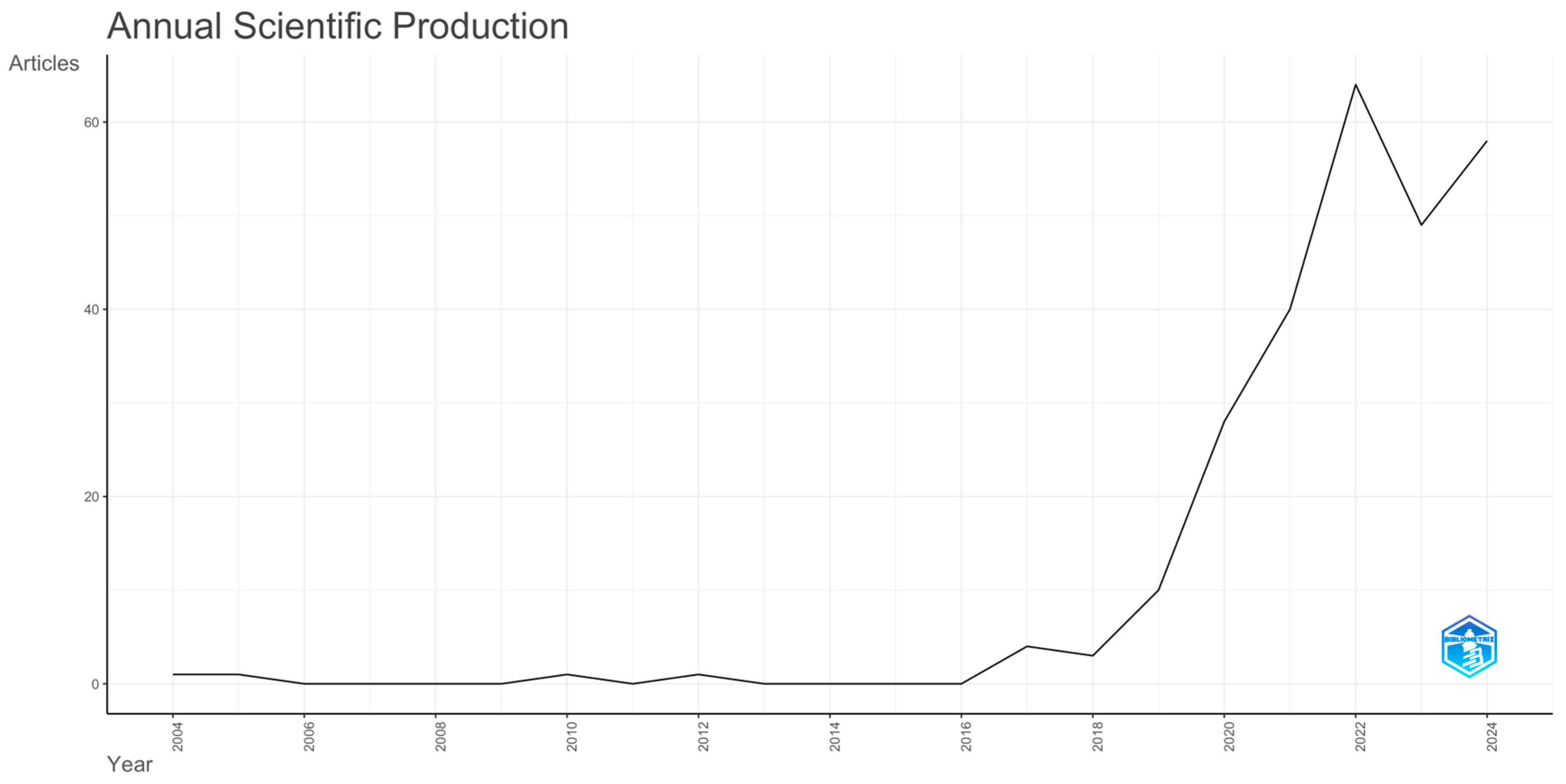
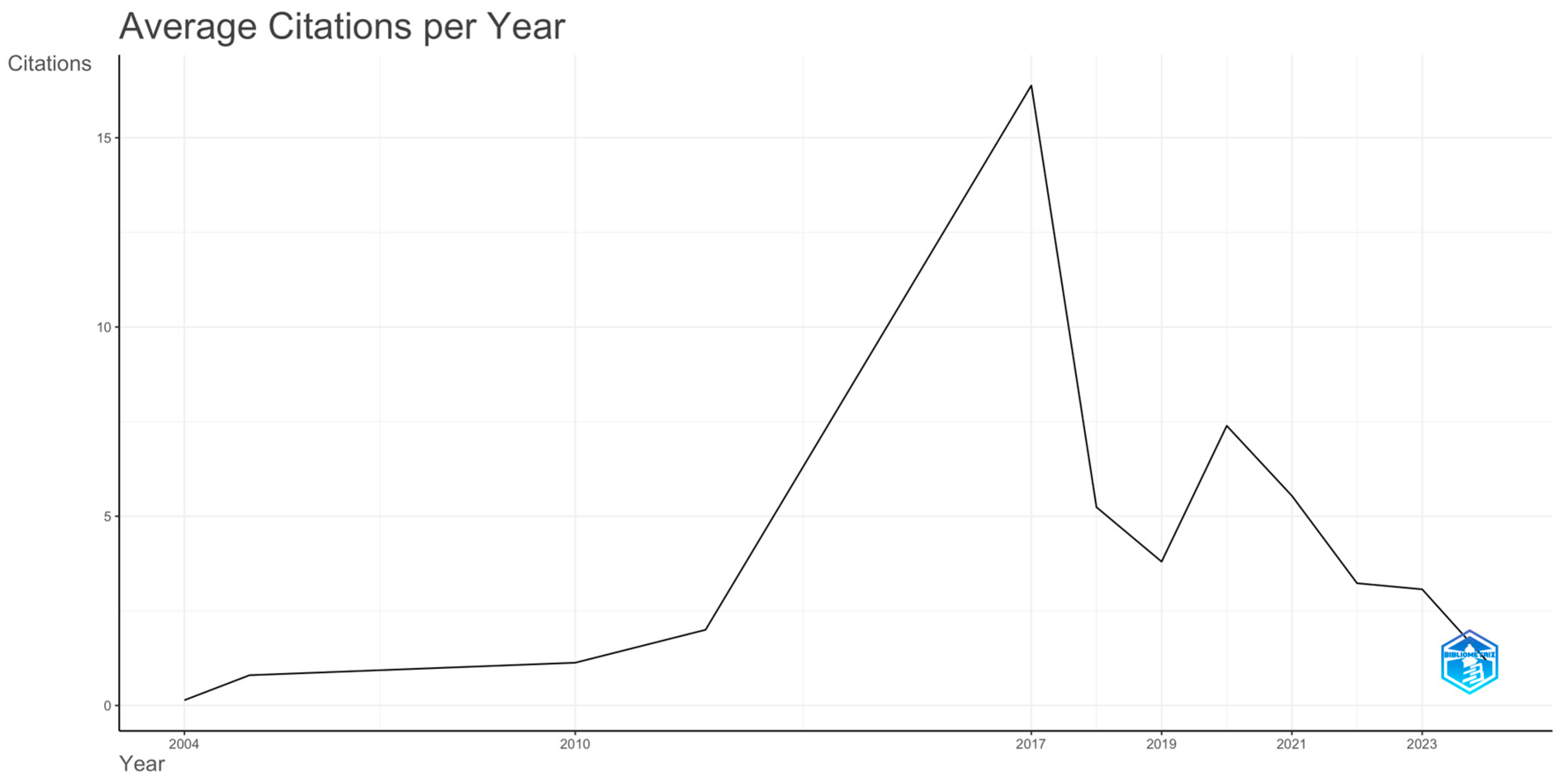



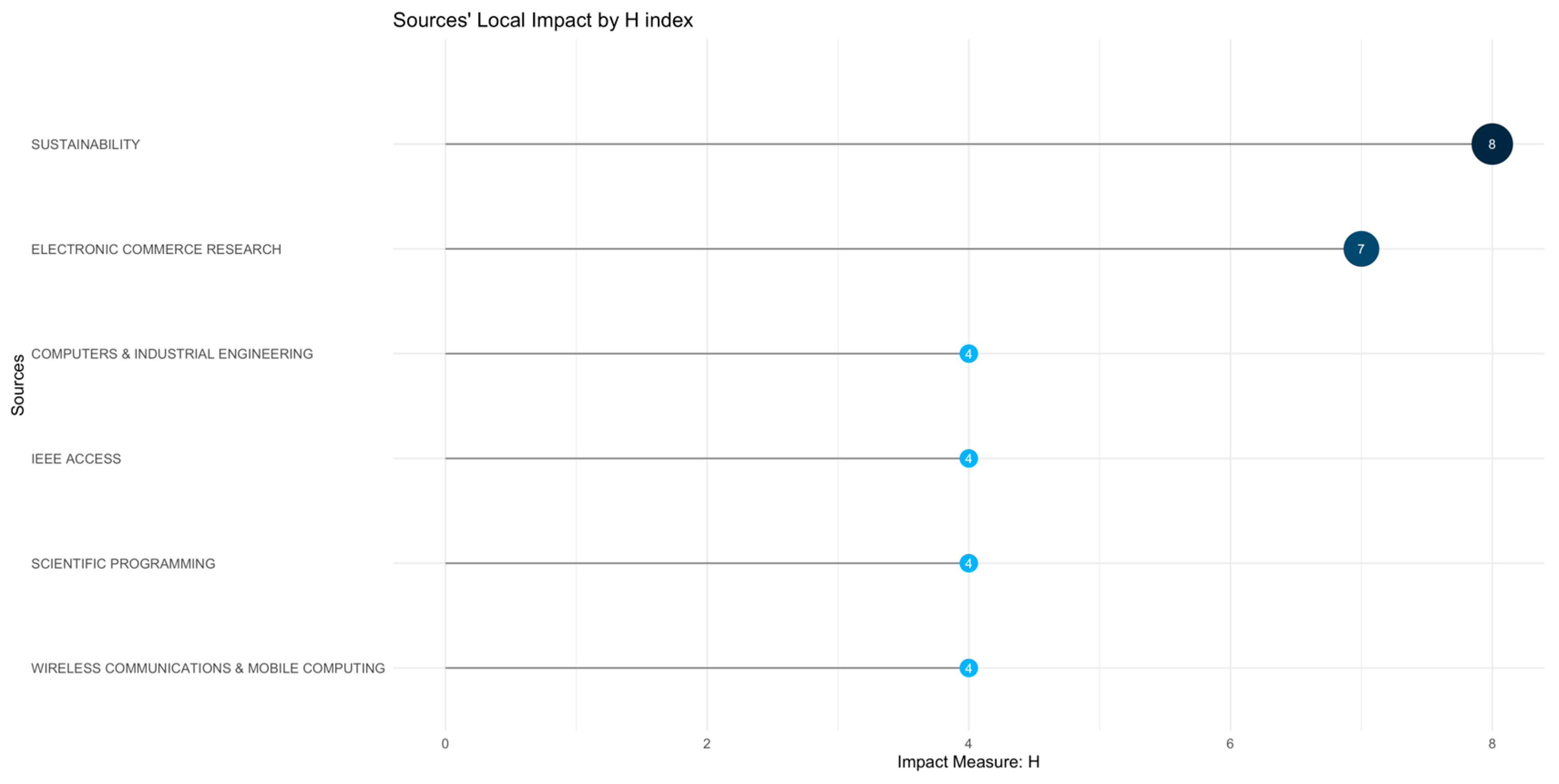




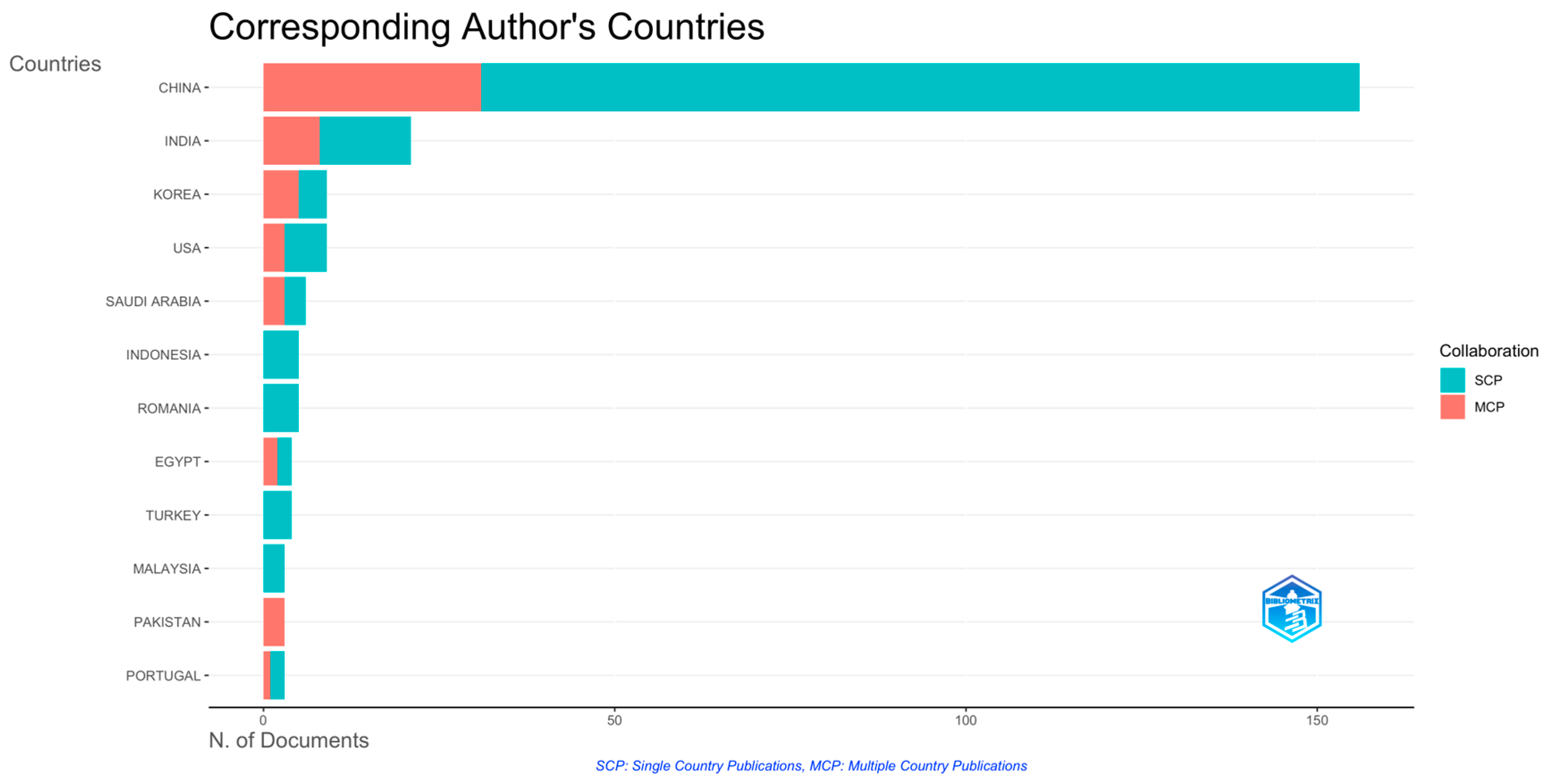



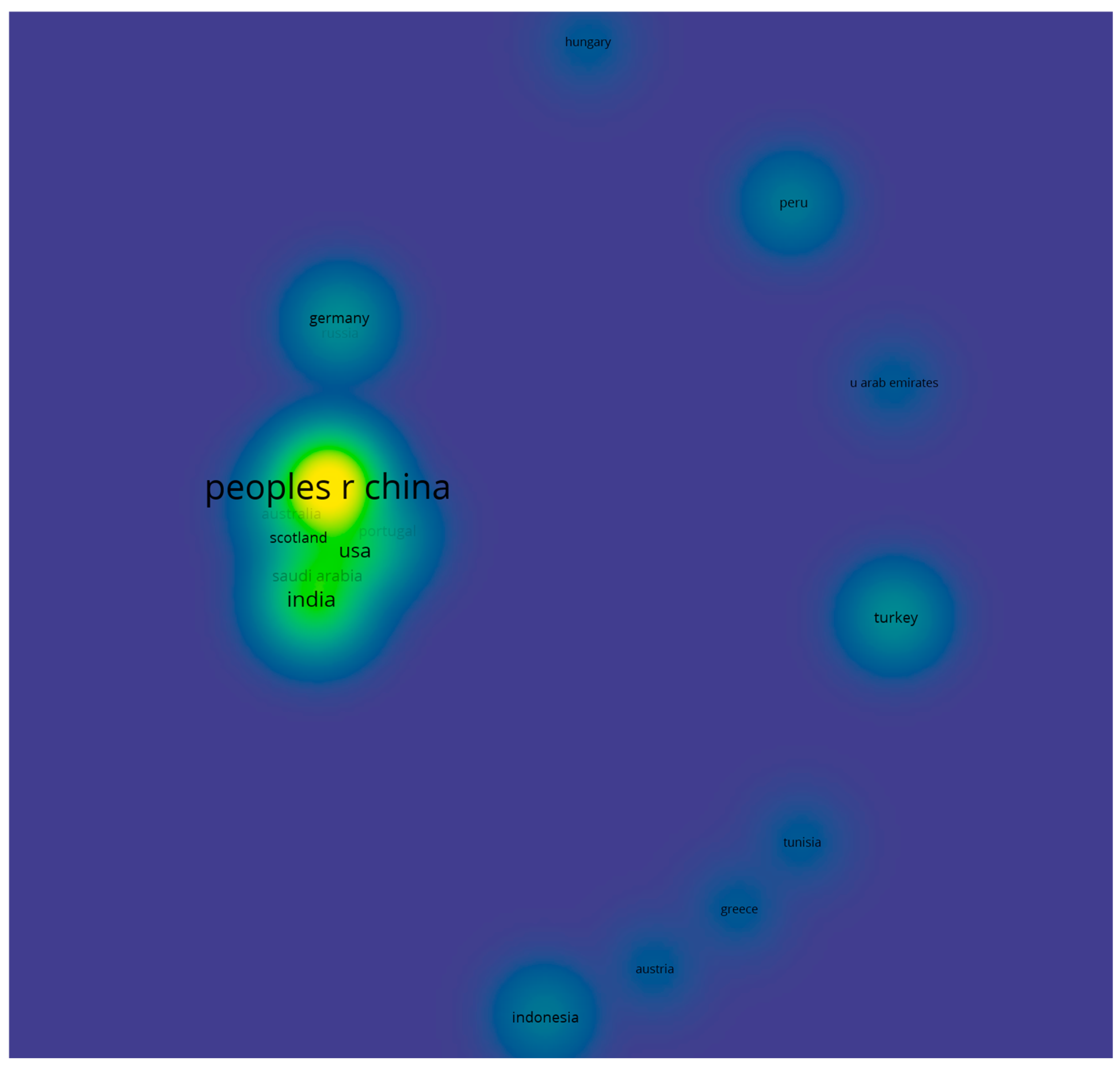

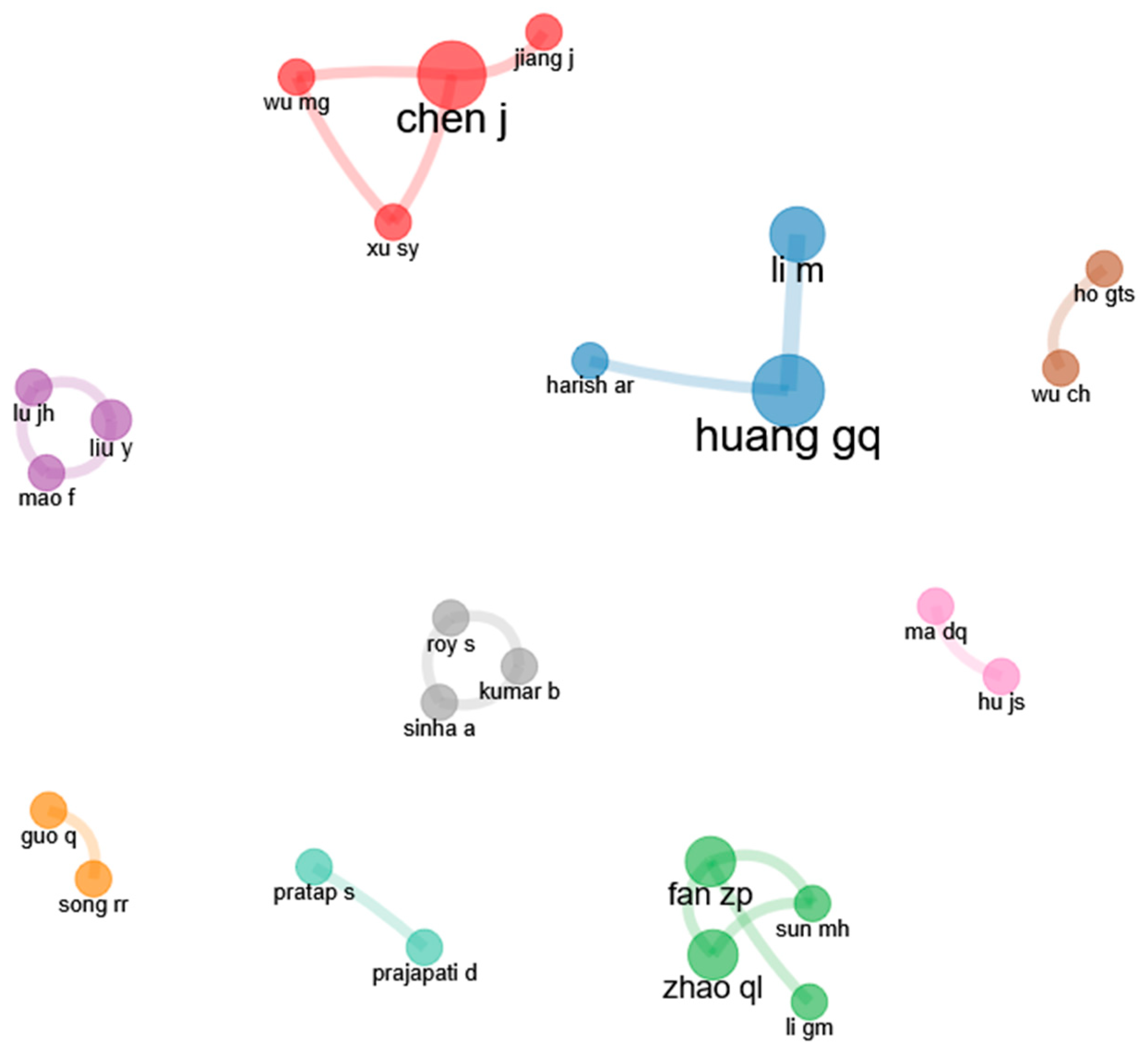
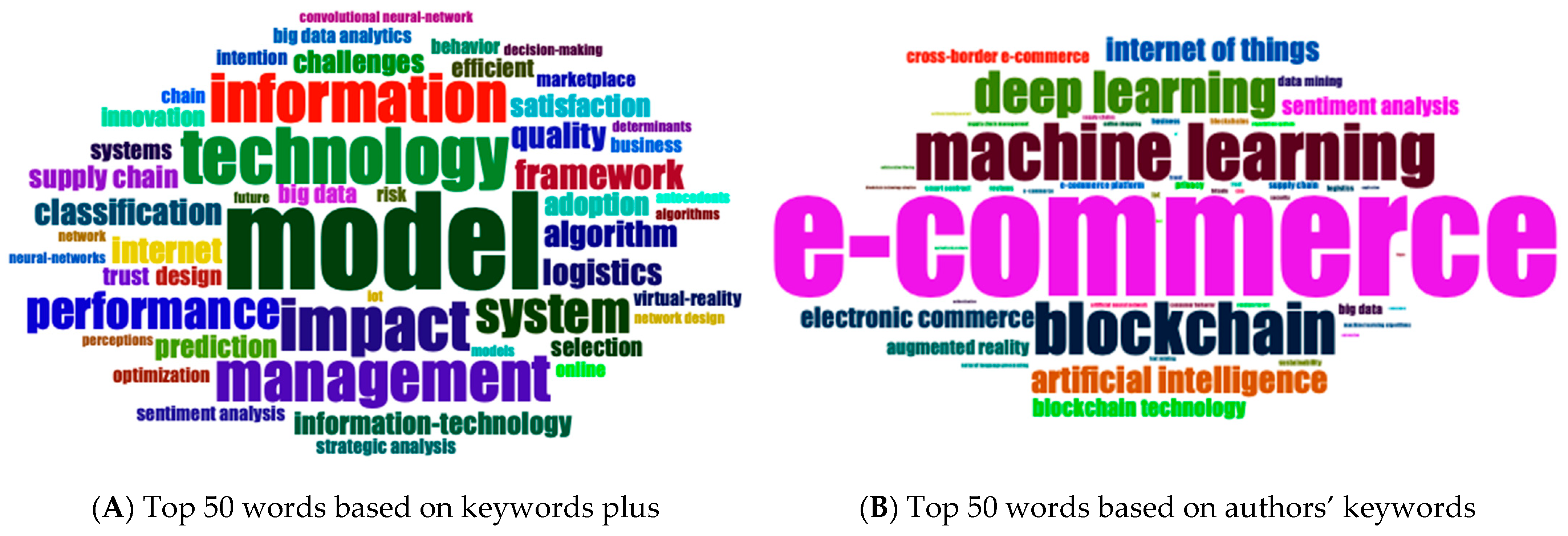
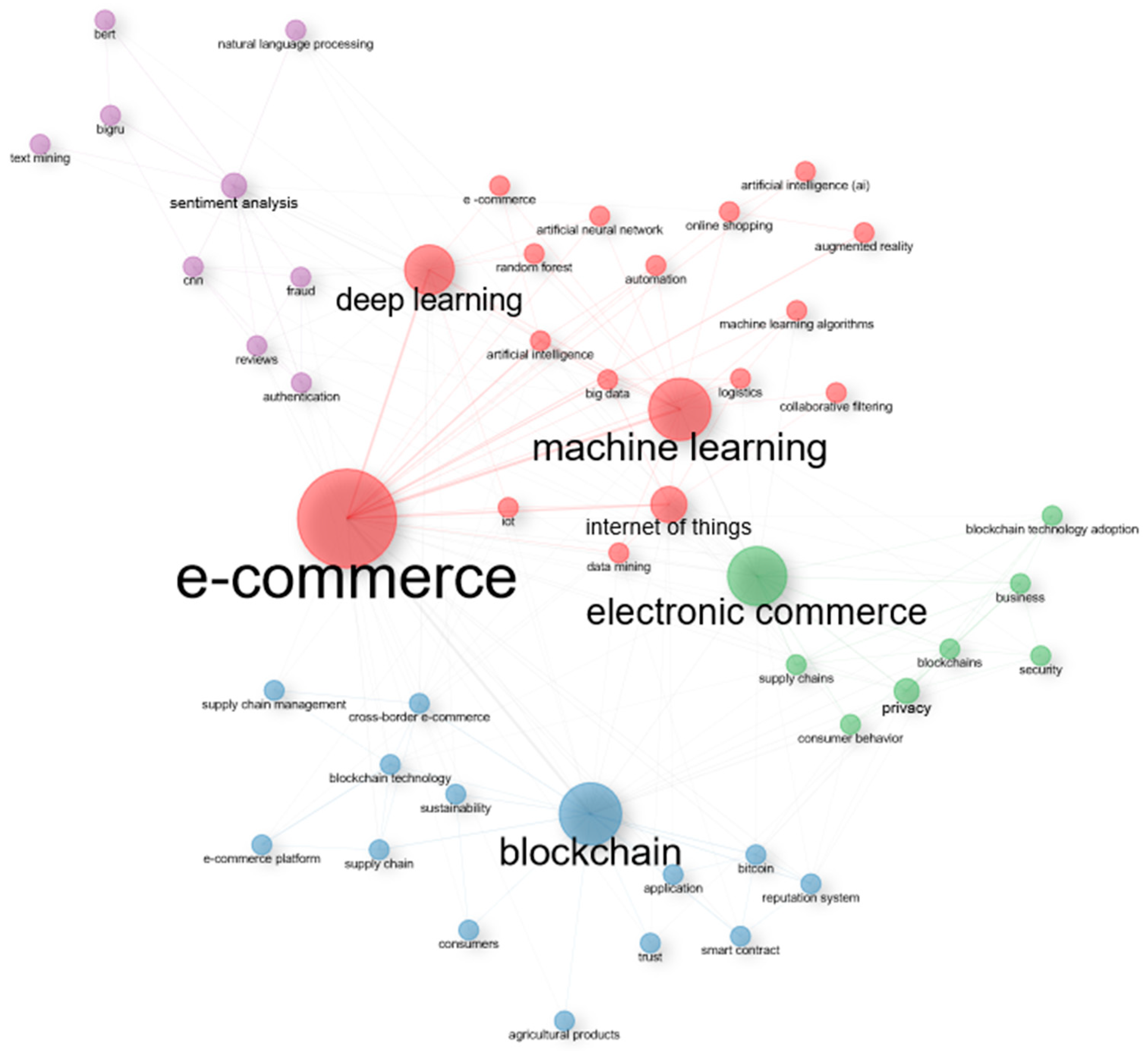
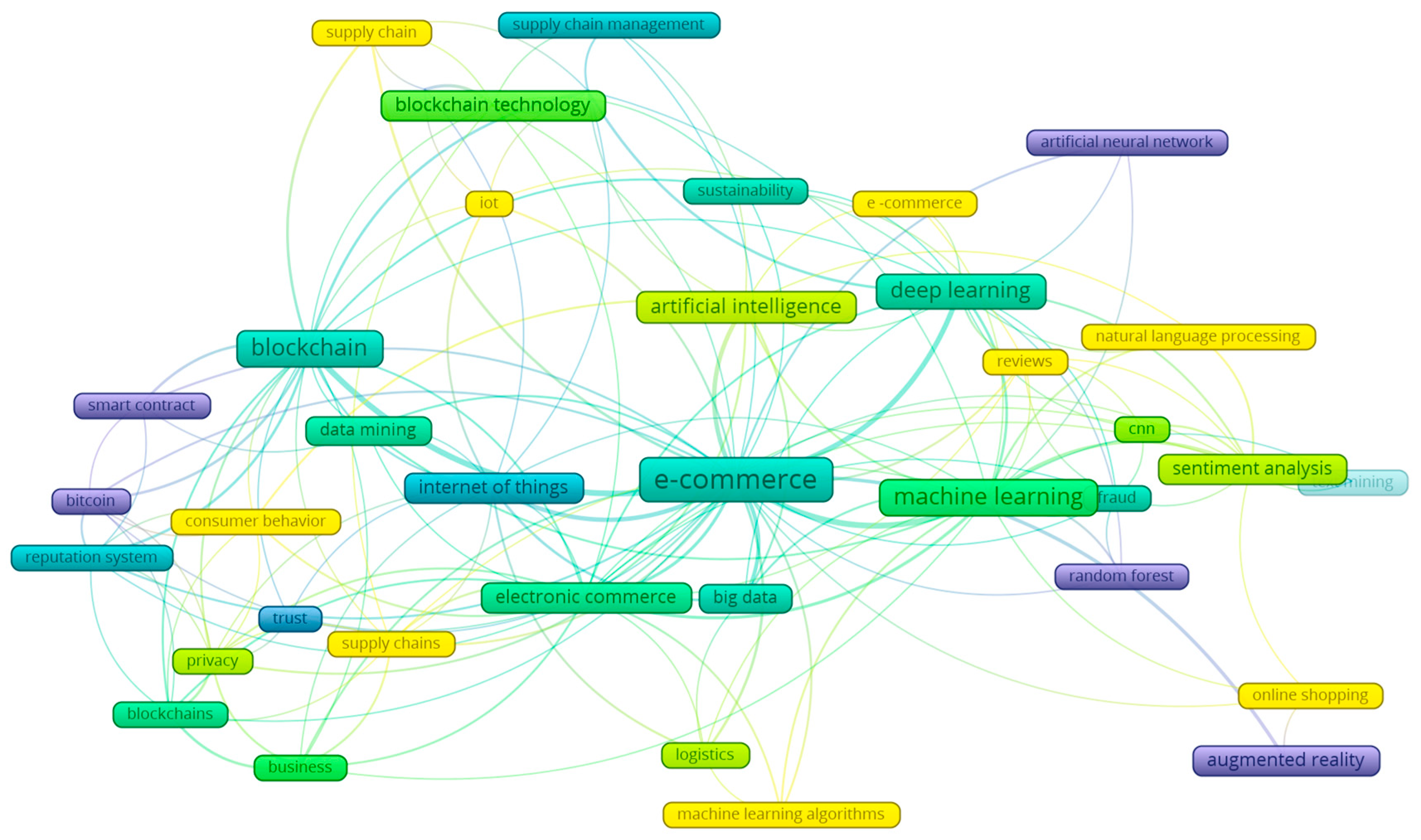



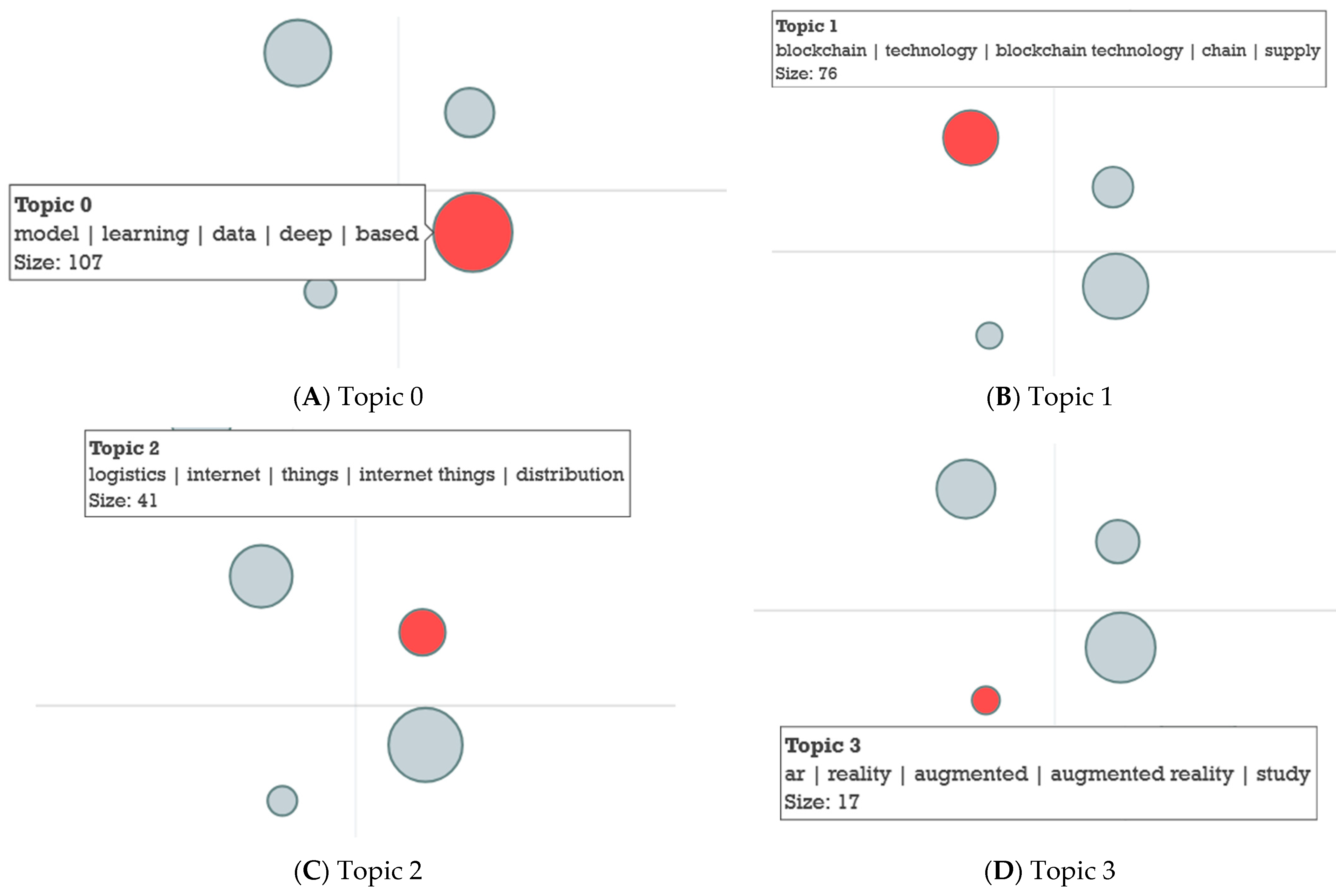


| Exploration Steps | Filters on Web of Science | Description | Query | Query Number | Count |
|---|---|---|---|---|---|
| 1 | Title | Contains specific keywords related to electronic commerce | (TI = (e-commerce)) OR TI = (electronic_commerce) | #1 | 14,644 |
| Contains specific keywords related to emerging technologies | (((((((TI = (artificial_intelligence)) OR TI = (machine_learning)) OR TI = (blockchain)) OR TI = (Internet_of_thing*)) OR TI = (emerging_technolog*)) OR TI = (deep_learning)) OR TI = (distributed_ledger_technolog*)) OR TI = (augmented_reality) | #2 | 351,153 | ||
| Contains specific keywords related to both electronic commerce and emerging technologies | #1 AND #2 | #3 | 426 | ||
| 2 | Language | Limit to English | (#3) AND LA = (English) | #4 | 419 |
| 3 | Document Type | Limit to Article | (#4) AND DT = (Article) | #5 | 290 |
| 4 | Year published | Exclude 2025 | (#5) NOT PY = (2025) | #6 | 290 |
| 5 | Non retracted papers | Eliminate from the dataset the retracted papers | (#6) AND Retracted (Exclude—Search within all fields) | #7 | 260 |
| Indicator | Value |
|---|---|
| Timespan | 2004:2024 |
| Sources | 140 |
| Documents | 260 |
| Average years from publication | 2.19 |
| Average citations per documents | 14.74 |
| Average citations per year per document | 3.753 |
| References | 10,022 |
| Indicator | Value |
|---|---|
| Keywords plus | 379 |
| Author’s keywords | 791 |
| Indicator | Value |
|---|---|
| Authors | 732 |
| Author appearances | 804 |
| Authors of single-authored documents | 52 |
| Authors of multi-authored documents | 680 |
| Indicator | Value |
|---|---|
| Single-authored documents | 55 |
| Documents per author | 0.355 |
| Authors per document | 2.82 |
| Co-authors per documents | 3.09 |
| Collaboration index | 3.32 |
| No. | Paper (First Author, Year, Journal, and Reference) | Number of Authors | Region | Total Citations (TC) | Total Citations per Year (TCY) | Normalized TC (NTC) |
|---|---|---|---|---|---|---|
| 1 | Yim MYC, 2017, Journal of Interactive Marketing, [101] | 3 | USA | 476 | 59.50 | 3.63 |
| 2 | Liu ZY, 2020, International Journal of Information Management, [102] | 2 | China | 177 | 35.40 | 4.79 |
| 3 | Yang L, 2020, IEEE Access, [103] | 4 | China, UK | 174 | 34.80 | 4.71 |
| 4 | Kowalczuk P, 2021, Journal of Business Research, [104] | 3 | Germany | 135 | 33.75 | 6.09 |
| 5 | Zhang D, 2021, International Journal of Information Management, [105] | 3 | China, Singapore | 98 | 24.50 | 4.42 |
| 6 | Ren SY, 2020, Transportation Research Part E: Logistics and Transportation Review, [106] | 4 | China, Hong Kong, USA | 88 | 17.60 | 2.38 |
| 7 | Lahkani MJ, 2020, Sustainability, [107] | 4 | China, Poland, Russia | 86 | 17.20 | 2.33 |
| 8 | Moriuchi E, 2021, Journal of Strategic Marketing, [108] | 4 | USA | 81 | 20.25 | 3.66 |
| 9 | Chandra S, 2018, Journal of Electronic Commerce Research, [109] | 2 | Singapore | 79 | 11.29 | 2.15 |
| 10 | Tsang YP, 2021, International Journal of Production Research, [110] | 5 | Hong Kong | 77 | 19.25 | 3.48 |
| No. | Paper (First Author, Year, Journal, Reference) | Title | Methods Used | Data | Purpose |
|---|---|---|---|---|---|
| 1 | Yim MYC, 2017, Journal of Interactive Marketing, [101] | Is Augmented Reality Technology an Effective Tool for E-commerce? An Interactivity and Vividness Perspective | Interactivity and vividness evaluation. Analysis of Covariance (ANCOVA). Structural Equation Modeling (SEM). Cronbach’s Alpha. Composite Reliability (CR). Convergent and Discriminant Validity Tests. Harman’s Single Factor Test. Sentiment analysis. Text analysis. | Two datasets including a total of 1059 responses from USA college students. First dataset involved 258 students, while the second dataset involved 801 students. | Analyze the effectiveness of augmented reality technology for e-commerce platforms and compare it to traditional web-based product presentations. |
| 2 | Liu ZY, 2020, International Journal of Information Management, [102] | A blockchain-based framework of cross-border e-commerce supply chain | Blockchain Framework. Core Algorithms and Methods (information anchoring method, key distribution method, information encryption algorithm, anti-counterfeiting method). | Digital documents, IoT data, transaction records, traceability tags, and smart contract execution records used for evaluating the framework. | Propose a novel framework based on blockchain for enhancing product traceability and transaction security in cross-border electronic commerce supply chain. |
| 3 | Yang L, 2020, IEEE Access, [103] | Sentiment Analysis for E-Commerce Product Reviews in Chinese Based on Sentiment Lexicon and Deep Learning | Sentiment lexicon. Convolutional Neural Network (CNN). Attention-based Bidirectional Gated Recurrent Unit (BiGRU). | 100,000 book reviews gathered from Dangdang. | Improve the sentiment analysis of products’ reviews from e-commerce platforms, by developing an efficient model, namely SLCABG, based on sentiment lexicon and deep learning algorithms. |
| 4 | Kowalczuk P, 2021, Journal of Business Research, [104] | Cognitive, affective, and behavioral consumer responses to augmented reality in e-commerce: A comparative study | Mean comparisons. Structural Equation Modeling (SEM). Multi-group Analysis (MGA). | The answers from an online questionnaire about IKEA (AR application versus mobile website), filled in by 400 students at a German University, between November and December 2018. | Compare consumer responses to AR versus web-based product presentations in electronic commerce associated with IKEA’s company. |
| 5 | Zhang D, 2021, International Journal of Information Management, [105] | Artificial intelligence in E-commerce fulfillment: A case study of resource orchestration at Alibaba’s Smart Warehouse | Case analysis (resource orchestration, interaction and co-evolution of AI and human capabilities) | Data from secondary sources—early 2018 (media, company websites, articles from Internet). Primary data (25 interviews from employees and managers in Alibaba’s Smart Warehouse) Other notes, videos, photos during interviews. | Investigate the way in which AI is used to improve business processes in Alibaba’s Smart Warehouse. |
| 6 | Ren SY, 2020, Transportation Research Part E: Logistics and Transportation Review, [106] | Intelligent service capacity allocation for cross-border-E-commerce related third-party-forwarding logistics operations: A deep learning approach | S2SCL (Sequence-to-Sequence architecture based on Convolutional Neural Networks—CNN, and Long Short-Term Memory networks -LSTM). | Real daily logistics service demand (LSD) data, gathered between 2017 and 2018, from a 3PFL company which operates in Hong Kong. | Propose a novel approach based on deep learning (S2SCL) and proving its efficiency on allocating service capacity in international electronic commerce. |
| 7 | Lahkani MJ, 2020, Sustainability, [107] | Sustainable B2B E-Commerce and Blockchain-Based Supply Chain Finance | Blockchain. | Data from Alibaba’s reports. | Prove the efficiency of logistics and digital documentation by implementing a B2B blockchain model in Alibaba company. |
| 8 | Moriuchi E, 2021, Journal of Strategic Marketing, [108] | Engagement with chatbots versus augmented reality interactive technology in e-commerce | Cronbach’s Alpha. Structural Equation Modeling (PLS-SEM). Variance Inflation Factor (VIF). Stone–Geisser’s Q2 Test. Heterotrait-Monotrait Ratio (HTMT). | The dataset consists of 68 undergraduate students’ (with ages between 18 and 24) answers about their perceptions and feelings related to augmented reality versus chatbot technologies. | Discuss the effects of chatbots and augmented reality (AR) in electronic commerce on customers’ engagement and decision-making. |
| 9 | Chandra S, 2018, Journal of Electronic Commerce Research, [109] | Exploring Factors Influencing Organizational Adoption of Augmented Reality in E-Commerce: Empirical Analysis Using Technology–Organization–Environment Model | Partial Least Squares (PLS). Latent Structural Equation Modeling (SEM). | A survey with 107 responses from managers who work for companies in India, Singapore, and the USA. The questions were related to their willingness to adopt AR within their organizations. | Explore the willingness of implementing AR within electronic commerce companies, by asking for managers’ standpoints, and propose an efficient model that has the power to maximize the organizations’ processes and sales. |
| 10 | Tsang YP, 2021, International Journal of Production Research, [110] | Integrating Internet of Things and multi-temperature delivery planning for perishable food E-commerce logistics: a model and application | Internet of Things-based multi-temperature delivery planning system (IoT-MTDPS). Two-phase multi-objective genetic algorithm optimizer (2PMGAO). Fuzzy logic. | Real data relevant for analyzing the perishable food electronic commerce logistics: environmental conditions, GPS locations, traffic details, customers, orders etc. | Propose an efficient IoT-MTDPS model for optimizing perishable food e-commerce logistics. |
| Words | Occurrences |
|---|---|
| model | 26 |
| technology | 15 |
| impact | 14 |
| information | 13 |
| management | 13 |
| system | 11 |
| performance | 10 |
| framework | 8 |
| algorithm | 7 |
| classification | 7 |
| Words | Occurrences |
|---|---|
| e-commerce | 80 |
| machine learning | 38 |
| blockchain | 35 |
| deep learning | 28 |
| artificial intelligence | 18 |
| internet of things | 16 |
| electronic commerce | 14 |
| blockchain technology | 12 |
| sentiment analysis | 12 |
| augmented reality | 10 |
| Bigrams in Abstracts | Occurrences | Bigrams in Titles | Occurrences |
|---|---|---|---|
| supply chain | 112 | deep learning | 50 |
| blockchain technology | 82 | machine learning | 41 |
| machine learning | 73 | artificial intelligence | 39 |
| deep learning | 72 | cross-border e-commerce | 26 |
| cross-border e-commerce | 61 | supply chain | 23 |
| e-commerce platform | 58 | e-commerce platform | 21 |
| e-commerce platforms | 57 | blockchain technology | 20 |
| artificial intelligence | 53 | augmented reality | 17 |
| agricultural products | 44 | e-commerce logistics | 14 |
| online shopping | 40 | learning model | 12 |
| Trigrams in Abstracts | Occurrences | Trigrams in Titles | Occurrences |
|---|---|---|---|
| e-commerce supply chain | 27 | e-commerce supply chain | 11 |
| artificial intelligence ai | 20 | deep learning model | 9 |
| augmented reality ar | 12 | machine learning approach | 8 |
| supply chain management | 12 | cross-border e-commerce logistics | 4 |
| machine learning ml | 10 | e-commerce platform based | 4 |
| convolutional neural network | 9 | e-commerce product reviews | 4 |
| data mining technology | 9 | blockchain technology adoption | 3 |
| deep learning model | 9 | closed-loop supply chain | 3 |
| machine learning methods | 9 | cross-border e-commerce supply | 3 |
| blockchain technology adoption | 8 | deep learning algorithm | 3 |
| Paper | Number of Citations in Various Databases | ||
|---|---|---|---|
| ISI WoS (Used in Present Manuscript) | Scopus | IEEE | |
| Yim et al. [101] | 476 | - | - |
| Liu et al. [102] | 177 | 305 | - |
| Yang et al. [103] | 174 | 439 | 394 |
| Kowalczuk et al. [104] | 135 | 236 | - |
| Zhang et al. [105] | 98 | 167 | - |
| Ren et al. [106] | 88 | 125 | - |
| Lahkani et al. [107] | 86 | 142 | - |
| Moriuchi et al. [108] | 81 | 138 | - |
| Chandra et al. [109] | 79 | 157 | - |
| Tsang et al. [110] | 77 | 106 | - |
Disclaimer/Publisher’s Note: The statements, opinions and data contained in all publications are solely those of the individual author(s) and contributor(s) and not of MDPI and/or the editor(s). MDPI and/or the editor(s) disclaim responsibility for any injury to people or property resulting from any ideas, methods, instructions or products referred to in the content. |
© 2025 by the authors. Licensee MDPI, Basel, Switzerland. This article is an open access article distributed under the terms and conditions of the Creative Commons Attribution (CC BY) license (https://creativecommons.org/licenses/by/4.0/).
Share and Cite
Sandu, A.; Cotfas, L.-A.; Ioanăș, C.; Cișmașu, I.-D.; Delcea, C. E-Commerce Meets Emerging Technologies: An Overview of Research Characteristics, Themes, and Trends. J. Theor. Appl. Electron. Commer. Res. 2025, 20, 320. https://doi.org/10.3390/jtaer20040320
Sandu A, Cotfas L-A, Ioanăș C, Cișmașu I-D, Delcea C. E-Commerce Meets Emerging Technologies: An Overview of Research Characteristics, Themes, and Trends. Journal of Theoretical and Applied Electronic Commerce Research. 2025; 20(4):320. https://doi.org/10.3390/jtaer20040320
Chicago/Turabian StyleSandu, Andra, Liviu-Adrian Cotfas, Corina Ioanăș, Irina-Daniela Cișmașu, and Camelia Delcea. 2025. "E-Commerce Meets Emerging Technologies: An Overview of Research Characteristics, Themes, and Trends" Journal of Theoretical and Applied Electronic Commerce Research 20, no. 4: 320. https://doi.org/10.3390/jtaer20040320
APA StyleSandu, A., Cotfas, L.-A., Ioanăș, C., Cișmașu, I.-D., & Delcea, C. (2025). E-Commerce Meets Emerging Technologies: An Overview of Research Characteristics, Themes, and Trends. Journal of Theoretical and Applied Electronic Commerce Research, 20(4), 320. https://doi.org/10.3390/jtaer20040320











